QuestionQUESTION: Hello,
My son asked for a gecko for Christmas (his only wish). We went to the pet
store and told them to give us everything that we need to help our baby
gecko. They gave us a tank, a wood hide out, sand, heating pad, crickets,
and a large tank. He has done well, but for the past few days, he has been
sitting in his water and is very lethargic. We have no clue what to do and our
son is in tears. Help! I have been reading about geckos online and it says
that we should have a temperature gauge as well in his tank. We don't....we
were not informed of that in the store. We will get one, but until then, is
there anything we can do for him? We are really sad and worried. Thanks!
ANSWER: Hi Michele,
Its typical of pet stores to give incorrect care. In most cases they are there to sell products and know very little if anything about the care the reptiles need that they sell. First, its vital to remove the sand. Sand can be deadly to leos. The worst is the so called calci sand stuff which encourages the leos to eat the sand. Sand or other loose substrate can cause severe blockages. This is one reason why your leo may be sitting in the water as water soaks sometimes helps them go to the bathroom. Another reason, (which I doubt is the problem) can be too high of temperatures. The reason I don't see this as a cause is that you don't mention any over head lights that would possibly be causing too high of temperatures. Other causes of a blockage can be internal parasites(very common with pet store reptiles) or being fed too large of crickets. For correct sized food, the insect is no larger than the space between their eyes and no longer than their head. I've included a basic care sheet with links to more info and also to finding a vet that is able to treat reptiles. I highly suggest getting the leo to a vet so that a proper diagnosis and treatment can be made. I have my fingers crossed that all will be ok!! You will notice in the care sheet that there are several areas of care that the store did not cover with you that are very important to the leos health. If your leo was just sitting in the water I might be lead to think that he is just looking for a humid hide which helps with their shedding, but with him being lethargic, that worries me. Have you seen him at night? Is he active then? Leos are nocturnal so they sleep during the day.
BASIC CARE FOR A LEOPARD GECKO
Leopards are pretty easy to care for but they do need
special care. Here are some of the basic needs of your gecko.
HOUSING: The need to have at least a 20 gallon long tank for one Leo. This needs to have a secure fitting screen top...they can be quite the escape artists!!! They need to have a humid hide box.You can make this with something as simple as a small plastic dish with a hole cut in one side and a small mesh bag filled with some Sphagnum moss coconut bark or Peat moss that you mist.
I made mine out of the small plastic folgers coffee containers...I cut an opening in the lid..and put the moss in..they LOVE it. I use the terrarium moss in mine.
I use that on the warm side of the tank. Be sure to provide a cool hidebox on the other end. I also provide a mid temperature hide...which is in the middle of the tank.I use the critter caves which you can purchase. NOT the ones that have heat in them!!!!
Provide secure climbing areas for your gecko. Fake plants, rocks and branches are all fine to use. be sure there are no wires or sharp ends to any fake plants you use.
*****SUBSTRATE:(that's the stuff on the floor of your tank) Newspaper, lizard carpet or paper towels work great and are easy to clean and are much safer than any loose substrate. Sand or other loose substrate is not recommended as that they can be deadly to the leo when it is ingested(eaten, even by accident while eating their insects)...A very graphic site of an impacted leo surg can be seen at http://homepage.mac.com/exoticdvm/reptile/PhotoAlbum181.html it is very graphic!!! ******What I have found that works great for safety and heat distribution is using about 1/4 inch of childrens play sand(since the tiles fit tight together, there is no sand danger) on the bottom of the tank and on top that you place ceramic or slate floor tile. What is nice is that the 12 x 12 squares fit perfect in a 20 gallon tank with no spaces between the tiles. The sand and the tile distribute the heat wonderfully. Using the under tank heater as described is what distributes the heat. Also, overhead heat will help in heating the tiles...I've been using this set up for several years and the leos love it. Using a tile that isn't smooth is recommended. **********
TEMPERATURES: They need a warm area of 88-92 degrees and a
cooler area in the upper 70s, low 80s. At night their temperature can drop to the low to mid 70's.
Never use a hot rock for a leopard gecko...or any reptile.
They can severely burn any reptile. You can use a heating
pad under the tank,under tank heater, or you can use a regular household lightbulb in a dome fixture with a ceramic socket in it to keep the warm area at the 88-90 degree area.At night, no white light. If room temperatures stay above 70 degrees, no extra night heat is needed. The undertank heater or heating pad should cover about 1/3 of the tank....be sure to raise the tank up about 1/4-1/2 inch off the stand when using an undertank heat source to prevent heat build up which can cause the glass to break and hot spots in the glass. Be sure to have a good layer of newspaper, carpeting or, even a thin flat rock(such as tile) on top the area that the undertank heat source is placed...if you use a thin rock or tile, it helps to distribute the heat very well.
You can use the special nighttime lights that are designed for reptiles. I like using a ceramic heat emitter on a thermostat for nighttime heat.
DO NOT use black lights or party lights as they can cause eye damage!!!!
The wattage you use will vary based on room temperature and size of tank.
LIGHTING: Leopard geckos do not need UVB lighting but it does not hurt them to give them uvb. They should have some type of light during the day, be it a uvb tube, regular florescent light, reptile day light or regular household lightbulb. NO white lights at night!!!
FEEDING: Geckos should not be fed crickets or other insects that are bigger than the space between their eyes. Generally, hatchlings can be fed more than once a day,juvys can be fed twice a day, adults are fed once daily or every other day, in the early evening. Crickets and other food items such as silk worms, super, and an occasional treat of a wax worm, need to be dusted with a calcium supplement two times a week and also they should have a small dish of calcium in their tank. I use the lid of a milk jug for the little dish of calcium in their tank. For dusting the insects, Use a calcium with no added phosphorus. Insects must be gut loaded(fed) for at least 48 hours prior to feeding your gecko. Remove any uneaten crix or superworms after 15-20 minutes..... Place a piece of cut potato in the tank so that if you have missed any uneaten insects, they will eat the potato instead of nibbling on your gecko!!!
*************You have to be sure to feed your crickets and insects the right foods before feeding them to your gecko. If your crickets/insects are not healthy and well fed, your gecko will not get the nutrition he needs. You can gut load your crickets and insects greens, veggies, cereals or specially designed commercial foods for crickets or the insects you are feeding. ************
Be sure to have a small dish of clean water for your gecko at all times!!
You can offer them some baby food or fruits on occasion ...
Mine will even eat a small piece of watermelon now and then.WATER: always provide a dish of drinking water. If you choose to mist your gecko to drink, its best to not get the tank too wet as that they do not do well with higher humidity. Sometimes its better to take your leo out of their tank to mist them to get them to drink!!!
HANDLING: Some geckos enjoy being held...others prefer not to be handled at all. Be sure to be very gentle when holding your leo and NEVER grab them by the tail! Their tails are extremely fragile and will break.
I do suggest finding a vet that can treat reptiles BEFORE you actually need one!!! To find a vet that is able to care for reptiles:
http://www.anapsid.org/vets
http://www.arav.org/Directory.htm
For more information on leopard geckos:
http://www.thegeckospot.com/leocareindex2.html
http://www.drgecko.com
If you have any questions or don't understand something, please let me know.
---------- FOLLOW-UP ----------
QUESTION: Thanks so much for your timely response. It was just what we needed to know.
I do have question about the sand. I understand that the pet store is just trying
to earn a buck, but they told us this was special fine sand that the geckos
should not have a problem with. Is this true? I don't believe them anymore.
Thanks again!
AnswerHi Michele,
Sorry to say...the pet store is way wrong on that info... here is a link:A very graphic site of an impacted leo surg can be seen at http://homepage.mac.com/exoticdvm/reptile/PhotoAlbum181.html it is very graphic!!! This is what happens when the so called safe sand is used.
Place a capful of the calcium in the tank as I suggested and your leo will lick at that when they have a need for some extra calcium without the deadly risk of eating sand.
Actually, if you read the fine print on many of the bags of the bark and other litters, many even state to remove the reptile for meals as that possible ingestion of the substrate can cause blockages and other injury...
Use the tried and true items for on the floor...I have the slate tile in my leos cages and it looks really nice, distributes heat well and easy to clean. In the spot the leo uses to potty...place a folded paper towel...makes cleanup a breeze!!

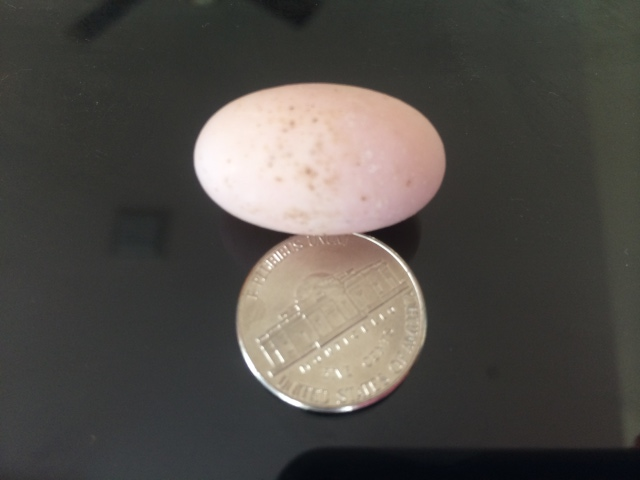 help identifying eggs I found - South Florida
Question
egg nest
Please, I found some egg
help identifying eggs I found - South Florida
Question
egg nest
Please, I found some egg
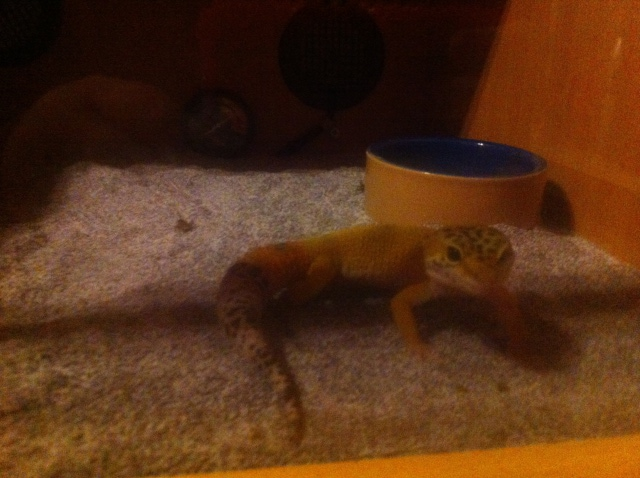 Eating habits in my leopard gecko
Question
Taken a few moths ago
Ive had my gecko
Eating habits in my leopard gecko
Question
Taken a few moths ago
Ive had my gecko
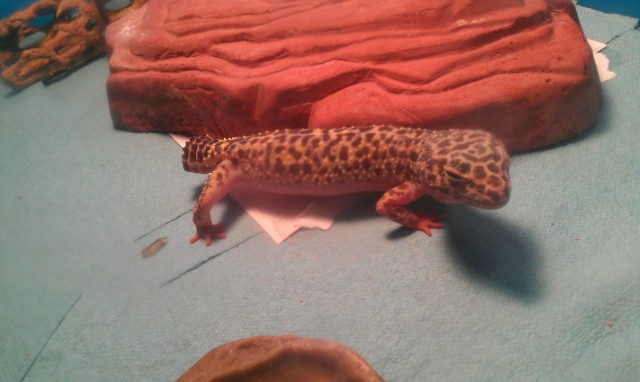 My leapord gecko please it got attacked by my cat
QuestionQUESTION: Please please IM in tears look my gec
My leapord gecko please it got attacked by my cat
QuestionQUESTION: Please please IM in tears look my gec
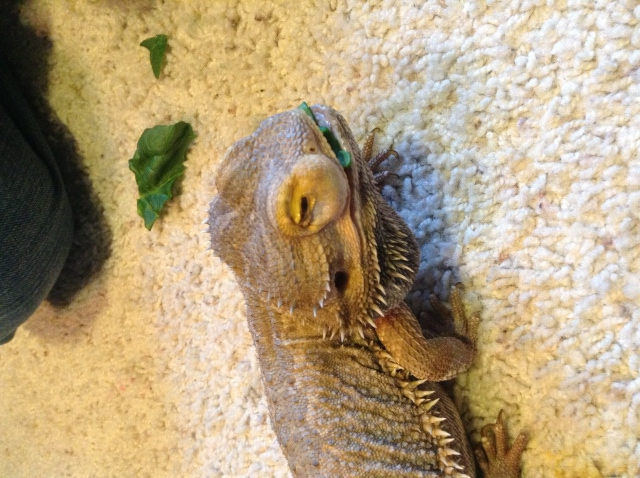 Rex hypovitaminosis A
Question
Rex Rex
This is the picture of hi
Rex hypovitaminosis A
Question
Rex Rex
This is the picture of hi
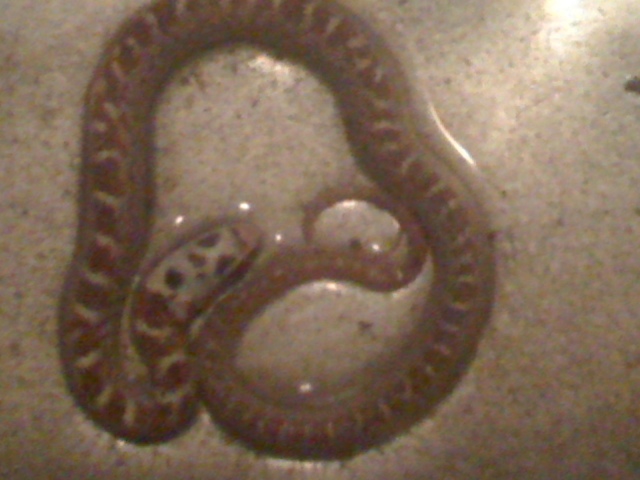 Snake ID?
Question
snake
This snake was found in my backyard. I h
Snake ID?
Question
snake
This snake was found in my backyard. I h